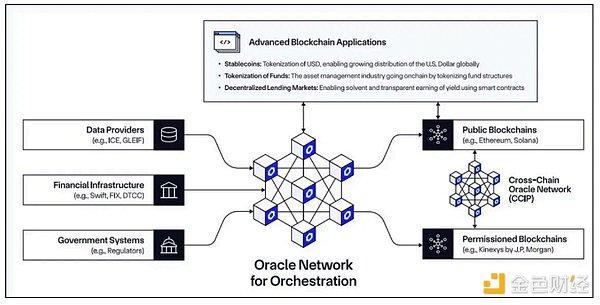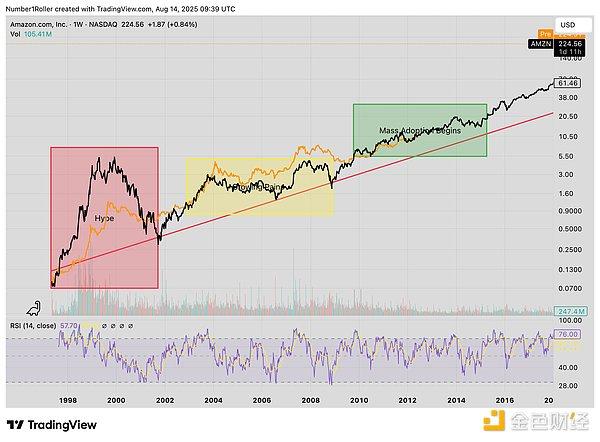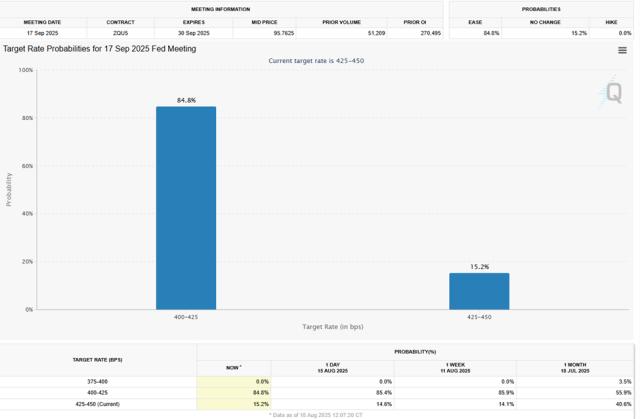Translated by: TechFlow
Key Points:
Stablecoins Become Core Infrastructure. Stablecoins, once driven by narratives, now demonstrate a clear product-market fit and are establishing their position as a core component of the digital economy.
AI Expectations Exceed Actual Development. Although AI was a major conference theme (occupying 11% of the agenda), many attendees noted the growing gap between industry hype and actual implementation progress.
Industry Enters Structural Maturity Stage. The crypto industry is transitioning from a speculative "frontier era" to a phase focused on infrastructure development and practical use cases. Market demand for verified applications and clear value propositions is gradually surpassing expectations for conceptual innovation.
1. TOKEN2049: Strategic Weathervane for Web3 Market Direction
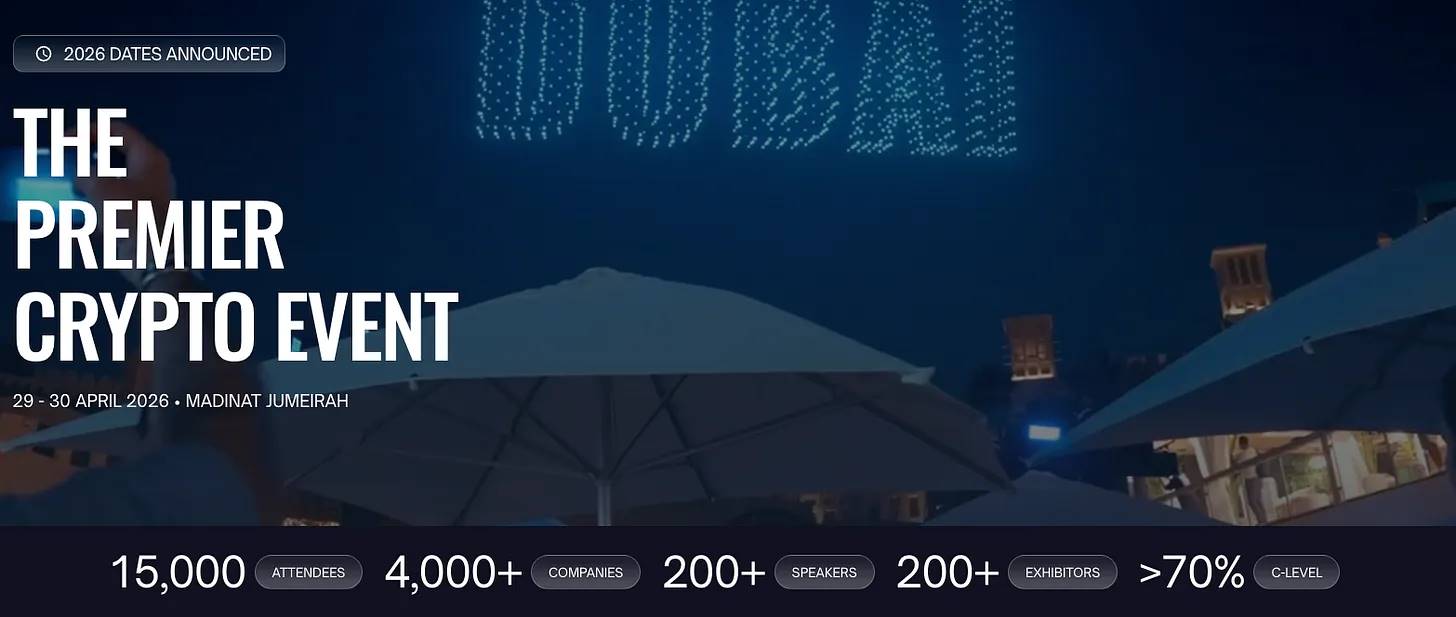
Source: Token2049
TOKEN2049 Dubai 2025 once again solidified its position as the top global crypto industry conference, attracting over 15,000 participants from more than 160 countries. The two-day conference covered a range of high-level speeches and discussions, reflecting market dynamics and emerging trends.
As an important industry forum, TOKEN2049 is seen as a barometer for the future direction and narrative shifts of the Web3 market. This report provides a systematic review of TOKEN2049 Dubai 2025, categorizing and deeply analyzing key announcements by core themes, while capturing changes in ecosystem priorities to offer strategic insights into the industry's future potential directions.
2. Emerging Trends: What Did the Agenda Reveal?
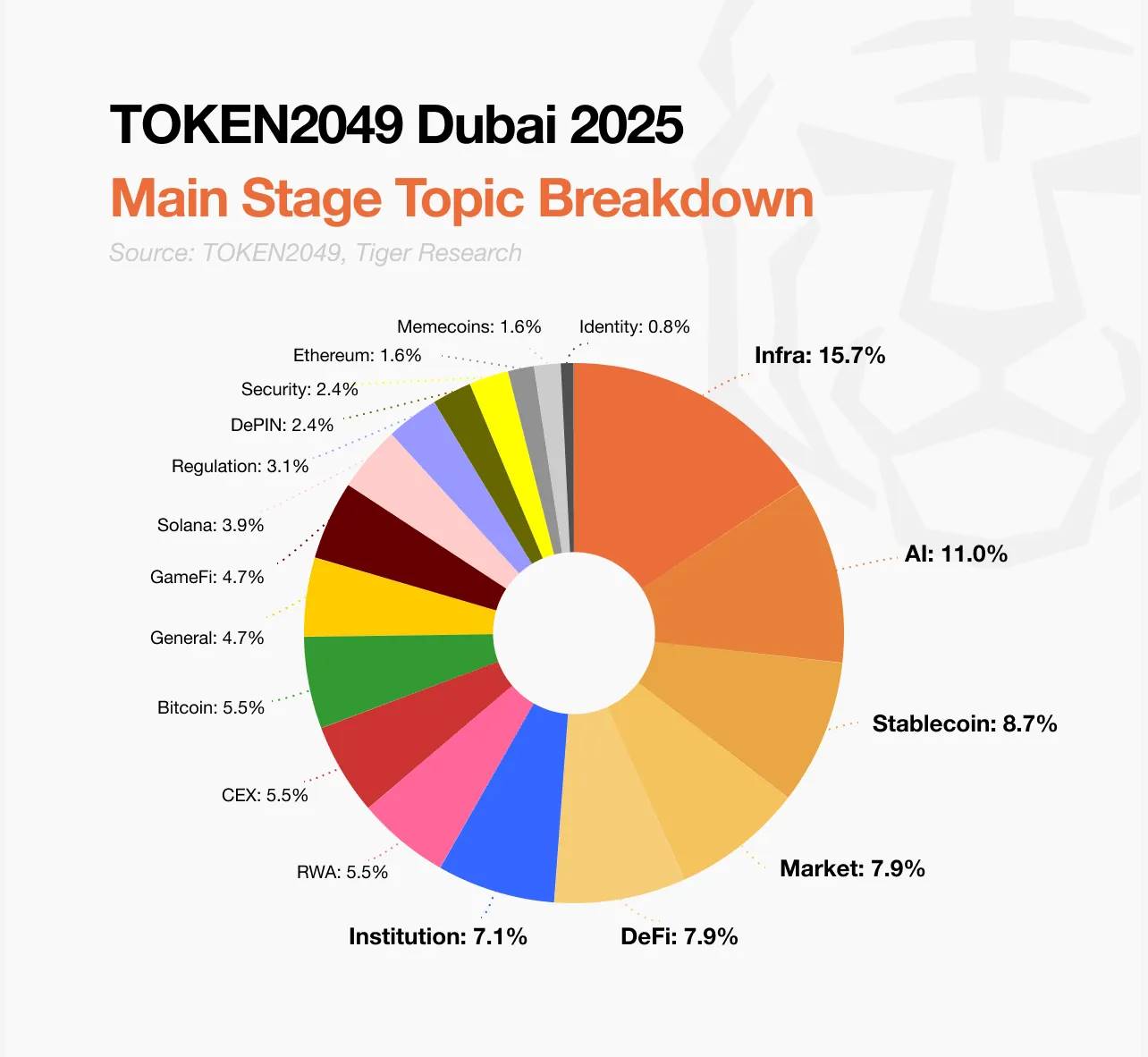
Source: TOKEN2049, Tiger Research
TOKEN2049 Dubai 2025 covered a wide range of blockchain topics, fully demonstrating the evolution of industry priorities. Infrastructure-related topics occupied the largest proportion (15.7%), followed by AI (11%). Although initial enthusiasm for AI agents has cooled, ongoing efforts to integrate AI with blockchain indicate that this theme remains structurally significant.
Notably, the combined proportion of stablecoins (8.7%) and real-world assets (RWA, 5.5%) has exceeded AI. This reflects growing market interest in blockchain applications with direct utility. Stablecoins are particularly noteworthy for their practical value in payments and settlements, while RWA has become the leading category of next-generation blockchain applications.

dYdX founder Antonio discusses hot topics: "Is DeFi consuming CeFi? Slowly and then suddenly."
Source: dYdX
In this year's DeFi discussions, industry perspectives are more mature compared to previous years. Rather than focusing on replacing traditional finance, discussions have shifted to how decentralized systems can complement existing institutions. This aligns with the overall industry trend towards regulatory engagement and institutional adoption.
A notable change is the increasing focus on the Solana ecosystem. Despite suffering a major blow during the FTX collapse, the Solana ecosystem has successfully rebounded, with its stage presence and technical discussion heat even surpassing Ethereum. This ecological dynamic shift is worth close attention and could potentially be a turning point in the Layer 1 blockchain landscape.
Overall, the main stage demonstrated a more grounded and pragmatic mindset. While eye-catching elements like meme coins and celebrity appearances still exist, they are merely secondary. Core discussions centered on long-term growth drivers, including regulation, financial integration, infrastructure development, and artificial intelligence.
3. Deeper Changes Beyond the Spotlight
As in previous years, the most meaningful progress often occurs off-stage. Side events and closed-door meetings reveal deeper industry trends, strategic reshaping, and fundamental directional shifts—factors that often impact the market before public narratives.
3.1 Stablecoins as Infrastructure
Stablecoins have now established themselves as core infrastructure for the digital economy and are viewed as a key opportunity in the Web3 domain. Increasingly, perspectives suggest that stablecoin transactions will expand from on-chain activities to the real economy, potentially forming a market worth trillions of dollars. This prospect is attracting more participants to the stablecoin sector.
With this view solidifying, the industry's focus has shifted from simple integration to controlling the payment layer. The goal is no longer limited to the issuance stage but extends to building end-to-end financial infrastructure. Web3 projects and institutions are racing to secure a leadership position in the stablecoin technology stack.
Although still in early stages, this transformation is driving ecosystems like Solana, Tron, and TON to accelerate establishing themselves as fundamental settlement platforms. Their strategies encompass not just stablecoin issuance but also wallet development, payment infrastructure construction, and institutional adoption.
3.2 AI in Crypto: Exciting but Still Experimental
Discussions about AI generally presented a cautious tone. Many attendees pointed out the widening gap between market enthusiasm and current technological development maturity. Particularly, some AI agent projects were criticized for lacking clear use cases, further deepening perceptions that most activities in this field remain speculative.
Despite these concerns, there is long-term confidence in Web3's potential role in the AI market. Concepts like decentralized AI computing and open-source agent frameworks are considered areas with actual potential. These are viewed as long-term opportunities rather than short-term trends, expected to gradually gain attention after the current market noise subsides.
While AI continues to attract broad attention, most attendees unanimously agreed that this field should be approached with a long-term perspective. The current focus remains on foundational experiments rather than immediate large-scale applications.
3.3 Node Sales Fever
A notable trend at the conference was increasing attention to node sales related to physical equipment. By opening node operations to a broader audience—an activity previously limited to a few groups—these initiatives are seen as an important step towards greater decentralization and redistributing participation opportunities.
However, some attendees were skeptical of this trend. They questioned whether these sales are merely retail financing strategies packaged as ecosystem participation. Criticisms focused on exaggerated reward structures, unclear token models, and lack of meaningful network activity to support sales.
Despite these doubts, multiple projects still attracted significant capital and attention. However, their long-term viability remains uncertain and will ultimately depend on the actual performance of network utility.
3.4 Technology Is No Longer the Sole Bargaining Chip
The gap between technological advancement and market adoption continues to widen. Even teams with strong technical capabilities acknowledge that continuous research alone is no longer sufficient to attract market interest. Many technologically mature protocols have failed to gain user attention, while some simple meme coins launched through meme platforms continue to generate stable trading volumes.
In response, industry participants are shifting their focus from research to execution. Increasing efforts are being concentrated on developing strategic market entry plans, understanding liquidity flows, establishing exchange relationships, and designing user-friendly token models. While technical excellence remains important, the ability to create meaningful value will be limited without an effective distribution strategy.
Market participants are increasingly concerned that short-term returns and immediate utility are taking priority over long-term innovation. In the current environment, execution capability trumps potential capability. The market has evolved into a competitive arena where technology alone cannot ensure survival.
4. Key Announcements
Tether – Launching New Compliant Dollar Stablecoin Plan
Tether CEO Paolo Ardoino announced plans to launch a new US-compliant dollar stablecoin, different from the existing USDT, expected to be released between 2025 and 2026. This plan reflects Tether's ongoing efforts in regulatory engagement and includes discussions with US legislators.
OKX – Launching OKX Pay and Institutional Collaboration Program
OKX launched OKX Pay, a crypto payment app supporting user self-custody with zero transfer fees, enabling wallet recovery through split-key technology. Additionally, OKX disclosed multiple institutional collaborations, including a partnership with Standard Chartered Bank in Dubai's VARA regulatory sandbox, and previewed integrations with Mastercard and Stripe.
Zodia Custody – Entering UAE Market and Strengthening Regulatory Cooperation
Zodia announced the acquisition of Tungsten Custody to establish a regulated business base in the UAE. Simultaneously, Zodia revealed a new custody partnership with Bybit and jointly published a custody framework with Abu Dhabi regulators.
Mesh – Retail Crypto Payment Integration
Mesh demonstrated a new integration with Apple Pay, allowing users to pay with cryptocurrencies while merchants receive stablecoins. This feature, based on Mesh's "SmartFunding" solution, is planned for launch in Q2 2025, aiming to simplify crypto payment processes in retail environments.
World Liberty Financial and TRON – $2 Billion Stablecoin Investment
MGX Fund from Abu Dhabi completed a $2 billion investment in Binance through stablecoin USD1. After the transaction, USD1 will be natively integrated into the TRON ecosystem.
MEXC Ventures – Launching Ecosystem Development Fund
MEXC Ventures announced a $300 million fund focusing on modular chains, ZK-rollups, and self-custody solutions. This move reflects renewed interest in infrastructure investment following the market downturn in 2022.
Lightspark – Bitcoin-Based Payment Infrastructure
Former PayPal executive David Marcus launched Spark, a native protocol based on Bitcoin's Lightning Network. The protocol aims to enable high-speed, low-cost payments, expanding Bitcoin's applications beyond "value storage".
These announcements align closely with TOKEN2049's themes. Stablecoins remain a core topic, with Tether's compliance plan and the $2 billion stablecoin investment case fully demonstrating this. Infrastructure development is another key focus, with companies like OKX, Zodia, and MEXC making notable efforts in scalability, custody, and modular architecture.
The evolving functionality of Bitcoin is emphasized through Lightspark's Spark protocol, further driving discussions about Bitcoin's broader application potential. Although AI occupied a significant position in the speaking sessions, it was relatively inconspicuous in the major announcements. Instead, the focus remained on practical deployment of payments, compliance, and institutional access, signaling the industry's continued transition from the experimental phase to scaled implementation.
5. Moving from Frontier to Urbanization Stage
This year's conference clearly demonstrated the transformation of the crypto industry—from speculative enthusiasm to a focus on utility and infrastructure development. Three key directional themes emerged:
Stablecoins Transcend Narrative, Becoming Digital Economy Infrastructure
Stablecoins are no longer just a concept but have shown tangible product-market fit, gradually establishing their position as core infrastructure for the digital economy.
AI Fever Rises, but Market Sentiment Remains Cautious
Despite AI receiving significant attention at the conference, many attendees noted that the market's enthusiasm is expanding beyond the actual maturity of AI technology.
Dubai Consolidates Its Position as Web3 Regulatory and Capital Center
The UAE continues to play a leading role in global Web3 expansion, with Dubai becoming a crucial regulatory and capital hub in this domain.
This conference did not introduce entirely new trend waves but emphasized further consolidation of existing narratives, particularly around AI, stablecoins, and real-world assets (RWA). The increasing institutional participation and continuous refinement of regulatory frameworks indicate that the market is entering a new stage of structural transformation.
The idealistic experimental era is giving way to a phase of pragmatic execution. Just as the transition from frontier to urban economy was driven by transportation and distribution revolutions, the Web3 ecosystem is now entering a stage dependent on infrastructure construction, system integration, and delivery capabilities.
Although the attention economy remains an important factor, the market is no longer solely buying into conceptual innovations. Stakeholders now expect actual applications and clear value propositions. This shift marks a broader maturation of the entire ecosystem, paving the way for more stable, long-term development—one could say, the arrival of Web3's "urbanization" era.




